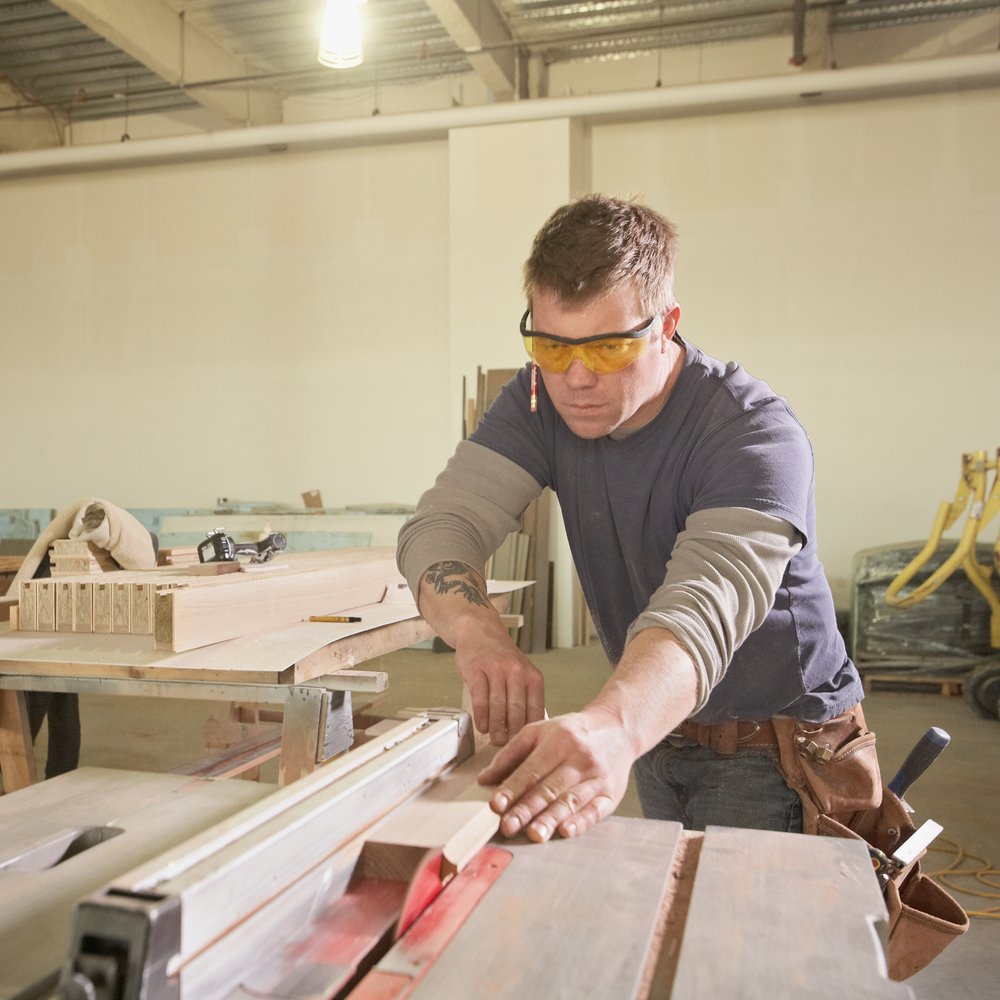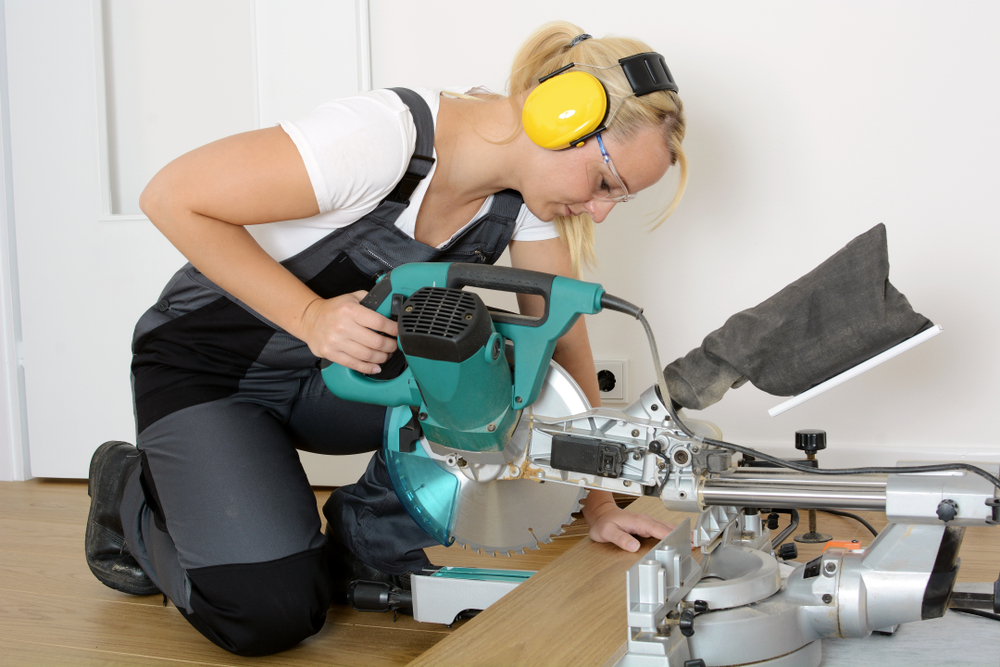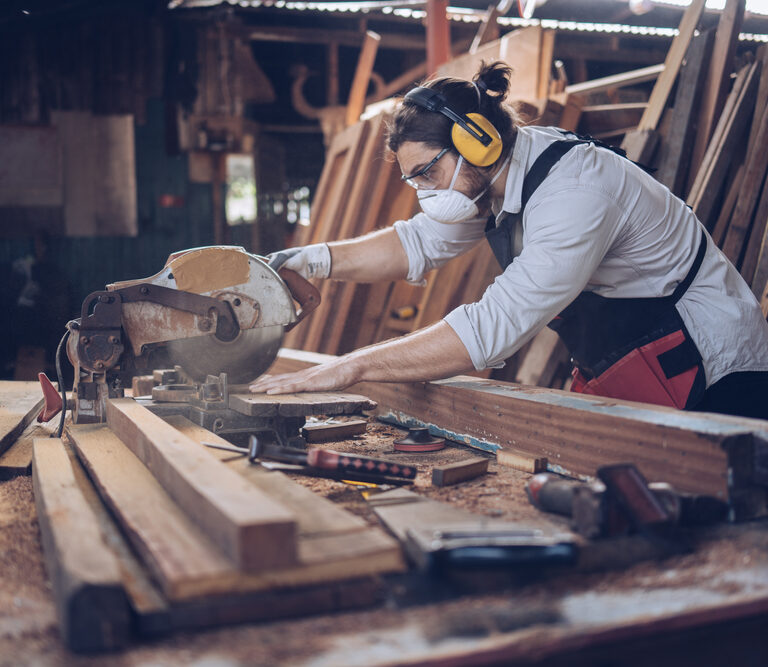Unless you are buying Swedish Flat Pack furniture, boards do not come perfectly sized for your project. You will need to cut them down to size and to do that, you need a saw.
The two main saws used in the woodworking world are the miter saw, and the table saw. If you are trying to decide which one to buy or use, this guide is for you.
A Quick Guide to Choosing the Right Saw
Before we dive into the nitty-gritty, let’s just do a quick breakdown. If you are standing with a beautiful piece of mahogany and need to make a decision right now, this section is for you.
Get a Table Saw if…
- You need to make long straight cuts
- You work with a lot of sheet goods
- You will be building cabinets, drawers, or other boxes
- You only have room for one large tool in your workspace
Get a Miter Saw if…
- You will be cutting a lot of boards to length
- You will be making a lot of angled cuts, like for moldings and frames
- You need a tool that is very portable
- You often cut materials other than wood
What Is a Table Saw?

A table saw is exactly what it sounds like; it’s a table with a powered circular saw blade poking out from the center of it. They can be small and portable, or they can have sliding beds capable of holding entire sheets of plywood.
The Benefits of a Table Saw
Table saws are the backbones of any woodshop. They offer much greater accuracy and safety over a circular saw, and the extra surface area they offer makes them very well suited for assembly and working with larger pieces.
You Can Make Long Straight Cuts
You can make crosscuts with a table saw, but where they really shine is while making long cuts. A good fence and a good rip blade will help you create the most accurate rips possible. That’s especially important if you plan on gluing up panels or butcher blocks.
Depending on the size of your table saw, you may even be able to put a straight edge on a board just like a planer by using a sled or attaching a running board. As long as you have at least two contact points with the fence, you will be making a straight cut, even if the board isn’t straight. Just make sure to watch out for twisting while straight-lining. The extra pressure can bind the blade and cause kickbacks.
You Can Easily Cut Sheet Goods
It is very difficult to be accurate when cutting a piece of plywood with a circular saw. A table saw can make it trivial. First, the table itself can support the piece so that you don’t have to figure out how to hold the material. That eliminates the need to dance around saw horses and coworkers who try to hold the wrong side of the board.
Second, you know you are making a straight cut as long as you are running against the fence. It’s hard to overstate the importance of making accurate straight cuts. If you are making panels, doors, boxes, shelves, or anything similar, your first cuts dictate the accuracy of the whole project. A table saw is how you get your first cuts to be accurate.
You Can Create Dados, Joints, and Shapes
One of the other major benefits of a table saw is that you can swap the blade out for a variety of different purposes. A dado pack can make rabbets and dados for cabinetry, and a shaped pack can make molding just like a big router.
You can even make beautiful joints without any additional blades or attachments. A glue joint that is half the board’s thickness by the blade’s width is an easy series of cuts to make and will greatly improve the strength of your glue work. You can also miter an entire box together. Table saws can tilt 45 degrees or more, so you can make mitered joints that are as long as you need them to be.
The Ability to Do It All
If you can only buy one large tool, in our opinion, it should be a table saw. We alluded to it above, but a table saw can do everything you need. You can make moldings with a table saw; it just takes longer than a shaper. You can do crosscuts with a table saw; it just takes longer to set up than a miter saw. You can even put a straight edge onto boards; it just takes a little bit more patience than a jointer.
You can also do some really tricky things with a table saw. Shooting boards can be clamped to the table so that you can push material through the blade at an angle. Sleds can be built that slide on top of the saw and allow you to hold awkwardly shaped objects.
The Downsides of a Table Saw
There are a few big downsides to a table saw. These downsides might be deal-breakers depending on the projects you want to complete and what kind of space you have access to.
There Are Safety Concerns
Table saws are very safe when used properly. However, they do carry a lot more risk than other types of saws. Boards can be kicked back with a huge amount of force if the blade gets bound or overheats. If you are positioned incorrectly behind the board when it kicks back, it can cause serious injury.
Worse, it is often necessary to remove the blade guard on a table saw in order to take advantage of some of the more advanced techniques. Without the guard, there is a greater risk of accidentally coming in contact with the blade. If that is a major concern to you, consider looking into the SawStop line of table saws that automatically retract the blade if they sense contact.
One of the best ways to stay safe with a table saw is to always work with a partner. Having someone that can support the boards, catch material, and hit the off switch if things go wrong can be better than any medical insurance you can buy.
Size
The size of the table saw is one of it’s greatest strengths since it offers more work surface and more support. However, if you are space limited, a table saw probably isn’t a good fit for your shop. Not only are they physically large, but they need a lot of room on all sides to make sure you can operate them safely.
Cost
Outside of specialized tools like a shaper or stroke sander, a table saw will likely be one of the most expensive tools you purchase. The cost extends beyond the saw itself too. New, better fences are expensive. Rollers and other supports, new blades to do different cuts, sleds, all of those accessories cost extra money.
What Is a Miter Saw?

Miter saws, sometimes called chop saws, resemble a circular saw attached to a small metal platform. You pull the saw blade down through the material that is either clamped or held tightly against the platform.
There are three main types of miter saws.
Compound Miter Saw
It’s rare to find a modern chop saw that is not at least a compound miter saw. A compound miter saw can create compound angles. The blade can tilt in one direction, usually up to -45 degrees, and the blade can be angled in relation to the fence. The angle of the blade to the fence often spans from -45 degrees to +55 degrees, but some saws can be different.
Double Compound Miter Saw
These saws are also called “double bevel” saws, and they are very similar to standard compound miters. The big difference is that the blade can tilt in both directions. That can be really convenient if you are doing a lot of casework or crown molding.
Sliding Compound Miter Saw
A sliding compound miter saw has the motor and blade attached to rails that allow it to slide in and out. The biggest benefit is that it gives you the ability to make cuts that are longer than the blade’s diameter.
They are also safer than their non-sliding counterparts since you can make many shallow cuts through the material. By scoring the material before cutting through it, you relieve any pressure and eliminate the risk of binding the blade. Sliding saws are often a lot more expensive, though.
The Benefits of a Miter Saw
The biggest benefits of a miter saw are mostly concerning speed. You can do everything that a miter saw can do with a hand saw or a table saw, but you can not do it as quickly or as accurately.
You Can Easily Cut Sticks to Length
Most of the time, you will have to cut the material you are working with to length. It doesn’t matter if you are building a house, building a cabinet face frame, or building a chair; you are going to be doing a lot of cutting to length. Nothing is faster or easier to use than a miter saw.
Just make sure to check the blade every so often for squareness. It’s easy to bump the saw with a 2×4 when you are in full production mode and knock it off 1 degree. Then you get to the end and start to stand the wall and find out it leans in a quarter bubble, and it’s just not a fun time.
You Can Cut Complicated Angles
It’s difficult to explain how difficult it can be to do things like cut in crown molding unless you have already experienced those frustrations. It’s hundreds of times more difficult if you don’t have the right tool for the job, and in this case, a compound miter saw is the right tool.
That is doubly valuable if you have to produce a lot of angles. Setting a new angle on a miter saw is trivial. It’s usually just a cammed lever that you move, and many modern saws have stops at common angles. You can trim out an entire room without ever having to re-setup your work area.
They Are Very Portable
Even the larger sliding compound miters don’t take up much space, and they only need enough room to fit the length of the materials you commonly cut. That makes them very convenient to take to job sites or use out in the field. There are even battery-powered miter saws on the market now, like this Dewalt.
One of the best accessories you can get for a miter saw is a folding stand. That way, you don’t have to work on the floor when you get to the job, and most stands have arms that support the material as you cut it. Those supports add an extra layer of safety and eliminate a lot of common frustrations.
You Can Cut a Variety of Materials
A miter saw can be outfitted to cut a lot of different materials. The ability to quickly cut materials to length is necessary in every trade. Plumbers and electricians need to be able to quickly cut PVC to length for piping or conduit, carpenters will often need to trim aluminum as well as wood, and welders need to make accurate cuts in bar stock.
You can get a miter saw to work with any of those materials. Common variants include the cold cut saw, which is for mild steel; the brick saw, which can cut stone and brick; and the abrasive disc chop saw, which can cut through almost anything.
The Downsides of a Miter Saw
There is really only one big downside to the miter saw. You are very limited in the size of the material you can cut. A miter saw that is not a sliding compound miter can only make a cut as long as the diameter of the blade, and it can only make that cut if you are cutting perpendicular to the length of the material. Once you change the angle, you are shortening the maximum length of the cut.
The problem is made worse because you can only cut material whose thickness is less than the blade’s radius. There is a nut holding the blade on that represents your maximum cut depth, so even a larger 12” sliding miter saw still has a maximum cutting depth of about four and a half inches. It will also have a maximum length of fourteen inches. If your board is any bigger than that, you are out of luck.
Stay Safe and Measure Twice
Until they invent a board elongator, the old saying “measure twice, cut once,” is still highly relevant. More importantly, stay safe. Wear safety glasses, make sure the material is firmly against the bed and the fence, and get a friend to help if you don’t feel comfortable. Materials and projects are replaceable; body parts less so. Have fun and best of luck on your next project.
